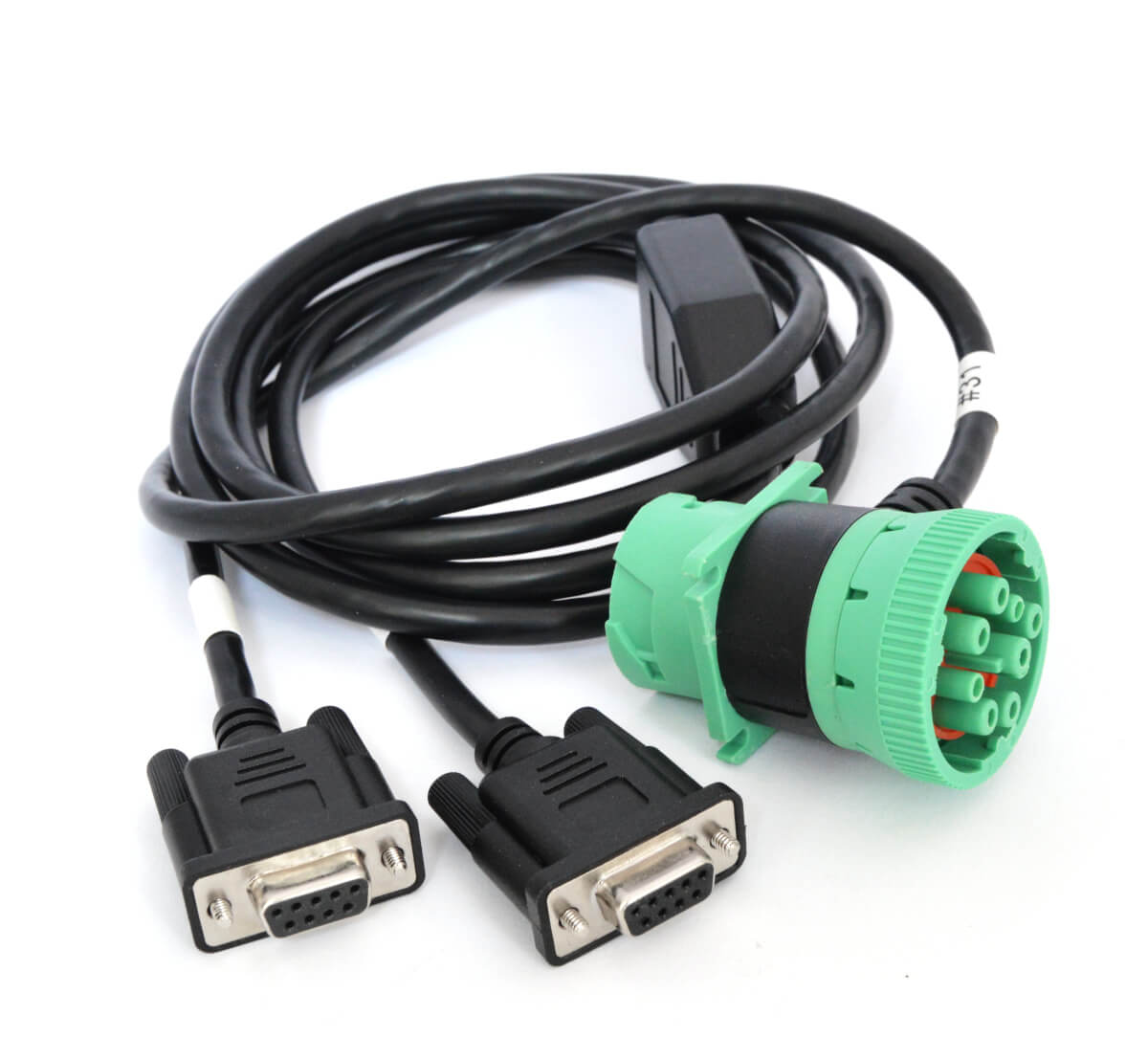
Log 2 x J1939 networks from supported heavy-duty vehicles
Access 2nd J1939 network via two options (pins H + J or F + G)
 TYPE II
TYPE II
Type II connector, supporting both green/black connectors
 SOLID CABLES
SOLID CABLES
Rugged quality 1.5m cable with overmolded DB9 connectors
 ROHS
ROHS
Cables are RoHS compliant and tested in Denmark
 1Y WARRANTY
1Y WARRANTY
We offer a 1-year warranty on all our products
About the adapter cable
This adapter cable is useful in heavy-duty vehicles (trucks, buses, tractors, ...) that provide access to multiple J1939 networks through a single deutsch 9-pin connector.
Specifically, the cable lets you connect a CAN bus data logger (like the CANedge) directly to the deutsch connector to both log the primary J1939 network (like our standard J1939 adapter), as well as a secondary J1939 network (if available).
This cable comes in two versions:
- H+J provides access via pins H (CAN-H) and J (CAN-L)
- F+G provides access via pins F (CAN-H) and G (CAN-L)
As an example, tractor diagnostic connectors will match the H+J version, providing you with access to both the J1939 and ISOBUS network in parallel.
If a heavy-duty vehicle has a deutsch 9-pin connector, it will in the vast majority of cases provide access to the primary J1939 network via the standard pins.
In such a case, you can either use this adapter cable or our standard J1939 adapter cable.
In some vehicles, there may also be a second network available via pins H and J or pins F and G. In this case, one of the two J1939-DB9/DB9 variants we offer can be connected to provide access to dual J1939 logging via e.g. a CANedge.
Note that we cannot say beforehand what data is available (if any) via a 2nd port for a specific vehicle. You will need to test this in practice, or review technical manuals for each vehicle you're interested in.
We primarily recommend to use a J1939-DB9/DB9 adapter cable if you know that there is a secondary J1939 network available - and if you know that you'll need data from it.
In most use cases, our standard J1939 adapter cable will be sufficient to give you access to the necessary data. Further, if no J1939 deutsch 9-pin connector is available, you may be able to use our OBD2/J1939-DB9/DB9 adapter cable or a CANCrocodile.
use cases
Check out our use cases, FAQ - or buy now!
Do you have any questions?
Contact us| GENERAL | |
|---|---|
| Adapter Cable Length | 150 cm |
| Adapter DB9 Pins | In accordance with CiA 303-1 |
| Cable Thickness | 22 AWG (0.50 mm2) |
| Connectors | 2 x 9-pin D-sub (DB9) female to J1939 9-pin deutsch connector |
| Type | Type II (compatible with both black Type I and green Type II connectors) |
| Connector Head | Passthrough (H + J) |
| Temperature | Operating temperature: -20degC to +80degC |
| Weight | 320G (H + J) |
| Color | Black |
Adapter pinout: J1939-DB9/DB9 (H+J)
| J1939 | Function | DB9 - CH1 | DB9 - CH2 |
| A | GND | 3 | N/C |
| B | VCC | 9 | N/C |
| C | CAN-H CH1 | 7 | N/C |
| D | CAN-L CH1 | 2 | N/C |
| E | N/C | N/C | |
| F | N/C | N/C | |
| G | N/C | N/C | |
| H | CAN-H CH2 | N/C | 7 |
| J | CAN-L CH2 | N/C | 2 |
Adapter pinout: J1939-DB9/DB9 (F+G)
| J1939 | Function | DB9 - CH1 | DB9 - CH2 |
| A | GND | 3 | N/C |
| B | VCC | 9 | N/C |
| C | CAN-H CH1 | 7 | N/C |
| D | CAN-L CH1 | 2 | N/C |
| E | N/C | N/C | |
| F | CAN-H CH2 | N/C | 7 |
| G | CAN-L CH2 | N/C | 2 |
| H | N/C | N/C | |
| J | N/C | N/C |
Below are two use cases examples where the OBD2/J1939-DB9/DB9 adapter is useful:
Vehicle fleet telematics
Need to log 2 x J1939 data from a truck fleet?
If you need to e.g. record data from a mixed fleet of trucks, the adapter provides a simple way to connect your CAN logger to log two J1939 networks from each truck. For example, the CANedge2 can log the primary J1939 network via Channel 1 and the secondary J1939 network via Channel 2 - all into the same log file, automatically being uploaded to your own server.
It differs by vehicle model/year/type what adapter cable is most suitable.
If there is only access to the primary J1939 network in the 9-pin deutsch connector, we recommend our standard J1939 adapter cable.
If two networks are accessible, the right variant depends on which pins are used. Some OEMs use pins H and J for the second network, others use pins F and G for the second network.
In cases where you have physical access to the vehicle, you may be able to visually inspect the connector to determine which pins seem to have metal heads inside, indicating that they are connected. This is a useful input in selecting the right adapter cable. Alternatively, you can get both cables to start with while you're performing tests.
When you have access to technical manuals for the vehicle, you may also be able to find the pinout specification through that.